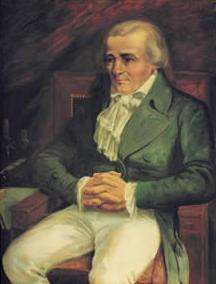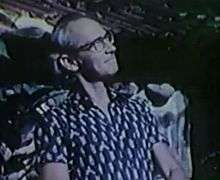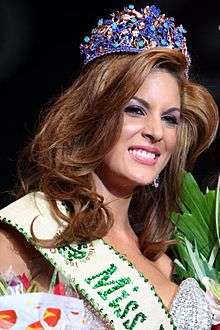Italo-Venezuelans
| ||||||||||
| Total population | ||||||||||
|---|---|---|---|---|---|---|---|---|---|---|
|
(1,500,000 to 1,800,000 Venezuelans of Italian descent 5–6% of Venezuela's population[1]) | ||||||||||
| Regions with significant populations | ||||||||||
| Caracas, Valencia, Maracaibo, Puerto La Cruz, Maracay, Mérida and surrounding areas. | ||||||||||
| Languages | ||||||||||
| Italian, Spanish | ||||||||||
| Religion | ||||||||||
| Roman Catholic | ||||||||||
Italian-Venezuelans are Venezuelan citizens of Italian descent. The word may refer to someone born in Venezuela of Italian descent or to someone who has emigrated to Venezuela from Italy. Among European Venezuelans, Italians are one of the largest groups of immigrants to settle in the country.
History
Before the discovery of huge deposits of oil in Venezuela, during the first half of the 20th century, the emigration of Italians to Venezuela was limited. A number of Italians (among them Agostino Codazzi) moved to Venezuela from Italy during the colonial times and the Simón Bolívar era.
The small, albeit constant, presence of travelers, explorers, missionaries and other peninsular and insular Italian immigrants over the course of almost 500 years made Venezuela acquire a Latin vocation instead of a Hispanic one. Venezuela was neither conquered nor colonized by Italians, who began arriving in massive numbers not during the colonial period but only in the last half of the nineteenth and the first half of the twentieth centuries. Yet Italians began to transmit a sound cultural heritage, giving and receiving demonstrations of social empathy, which contributed to their integration and to the huge flows into Venezuela from 1948 (for ten years). Italian immigration was a decisive factor in the modernization of production and commercial activities in urban and rural areas, as well as in changing the standard of living.Pedro Grau
In the 1940s and 1950s the Venezuelan President Marcos Pérez Jiménez promoted European immigration to his depopulated country, and more than 300,000 Italians emigrated to Venezuela (although many later returned to Italy).
The Italians in the 1961 Venezuelan census were the biggest European community in Venezuela (ahead of the Spanish). In 1976 the "Dirección de Estadísticas" of Venezuela registered 210,350 Italians residents and 25,858 Italians "naturalised" (that obtained Venezuelan citizenship).[2]
Marisa Vannini calculated that in the eighties Italian-Venezuelans made up almost 400,000 of Venezuela's population, including second-generation descendants of immigrants. The Italian language in Venezuela is influencing Venezuelan Spanish with some modisms and loanwords and is experiencing a notable revival between the Italian-Venezuelans of second and third generation.
Santander Laya-Garrido estimated that the Venezuelans with at least one grandparent from Italy can be nearly one million at the beginning of the 21st century (like the former president of Venezuela, Raul Leoni, whose grandfather was an Italian mason refugee of the 19th century).
Currently, Italian citizens residenced in Venezuela are reduced to less than 50,000 due mainly to demographic mortality and to their return to Italy (because of a Venezuelan political and economic crisis in the 2000s).[3] The Ambassador of Italy in Venezuela, estimated that 5-6% (1,44 to 1,73 million) of the current Venezuelan population is of Italian origin.[4]
Professions of the Italian-VenezuelansThe Italian contribution to the economic history of contemporary Venezuela has been essential, particularly in the industrial, trade, services and agricul- tural sectors. Since the arrival of the first massive inflows (in the 1950s), Italians took part in the process of replacing imports with the production in the country of light goods, an activity which accelerated as of the 1960s. A number of Italian immigrants used protectionist measures by the Venezuelan government and support by the Venezuelan Corporation of Economic Development, to establish small and medium industries, such as of food, shoes, metal-mechanics and others in San Cristobal, Acarigua-Araure, Barquisimeto, Aragua and Tuy, and construction firms in Caracas and the metropolitan centers. Likewise, many Italian businessmen reinforced their positions, particularly in construction, public works and transportation. Powerful Holdings in leather, shoes and vehicle-assembling also emerged (in Valencia). In addition, large corporations of Italian origin, like "Barsanti", participated in the huge industrial changes in the provinces, contributing to the implementation of hydroelectrical, steel and aluminum projects in Guayana, Bolivar state, as contractors of the Guayana's Venezuelan Corporation. The Italian presence.... has steadily contributed over the past 35 years to create a developed center in Ciudad Guayana. There are similar cases in west Venezuela, where a communication, irrigation and hydroelectrical infrastructure has been developed, particularly in the Andes, the southern area of Maracaibo Lake and the western "LLanos". A dynamic Italian industry, mainly agricultural, has been established in Barinas, Acarigua-Araure, San Cristobal, Maracaibo, Calabozo and Valle de la Pascua.Pedro Grau Initially the agriculture was one of the main activities of the Italian community in Venezuela. In the fifties entire Italian families were moved from Italy to special agricultural areas, like in the "Colonia Turén" of the Portuguesa region.[5] But most of the Italians concentrated in commercial, building and services activities during the second half of the 20th century. In those sectors the Italians reached the top levels of the Venezuelan economy. The main Italian newspapers of the community are Il Corriere di Caracas and La Voce d'Italia , both published in the Capital, while the main Italian school is the Agustin Codazzi of Caracas (with courses from elementary to high school). Since 2002, the Italian Government has become the promoter for a provision which makes it mandatory to teach the Italian language as a second language in a consistent number of public and private schools within Venezuela.[6] Most of the Italian community in Caracas (but even in all Venezuela) followed the Deportivo Italia football Club, as their own representative team.[7] Indeed, the Italian-Venezuelans have obtained significant results in the contemporary society of Venezuela. The Italian Embassy calculates that 1/4 of the Venezuelan industries, not related to the oil sector, are directly or indirectly owned and/or managed by Italian-Venezuelans.[8] In the Italian community, actually one of the most important in Venezuela, there are Presidents of Venezuela (like Jaime Lusinchi and Raúl Leoni), entrepreneurs (like ing. Delfino, who with his "Constructora Delpre" made in Caracas the tallest skyscrapers of South America: Parque Central Complex), managers (like Pompeo D'Ambrosio), sportsmen (like Johnny Cecotto), artists (like Franco De Vita), beauty pageants (like Daniela di Giacomo and Viviana Gibelli), and many others personalities. One winner of the title Miss Venezuela was born in Italy: Maria Antonietta Cámpoli [9] in 1972 (later she represented Venezuela in the Miss Universe, where she was the runner-up). Notable Italian-Venezuelans
Geographical distribution and originThe Italians who migrated to Venezuela came mainly from the regions of South Italy, like Abruzzo, Campania, Sicily, and Apulia, but there were also migrants from the north, such as from Emilia-Romagna and Veneto.  Areas of Venezuela where the Italian community is concentrated The Italian Consulate in Caracas stated[10] that in 1977 - of 210,350 Italians residents in Venezuela - 39,855 were from Sicily, 35,802 from Campania, 20,808 from Abruzzi, 18,520 from Apulia, 8,953 from Veneto, 7,650 from Emilia-Romagna and 6,184 from Friuli – Venezia Giulia. The Italians are concentrated mainly in the north-central region of Venezuela around Caracas. The Consulate stated that in the same 1977 there were 98,106 Italians in the Distrito Federal of Caracas, 39,508 in Miranda State, 14,203 in Maracaibo, 12.801 in Aragua State and 8,104 in Carabobo State, as well as 66 in the Amazonas equatorial region. In the 2000s, it was determined that nearly 90% of the Italo-Venezuelans were concentrated in the northern coastal section of Venezuela facing the Caribbean sea. Approximately 2/3 of them are residents of the metropolitan areas of the three main Venezuelan cities: Caracas, Maracaibo and Valencia. There is also a considerable amount of Italian residents that live in the city of San Cristóbal and in the Andes region. Main Italo-Venezuelan Institutions and Associations
EducationThe Colegio Agustín Codazzi in Caracas is an overseas Italian school recognized by the Ministry of Foreign Affairs of Italy.[13] There are also multiple Italo-Venezuelan schools in the country:[14] Caracas:[14]
Eastern Venezuela:[14]
Western Venezuela:[14]
See also
References
External links
Bibliography
| ||||||||||||||||||||||||||||||||||||||||||||||||||||||||||||||||||||||||||||||||||||||||||||||||||||||||||








